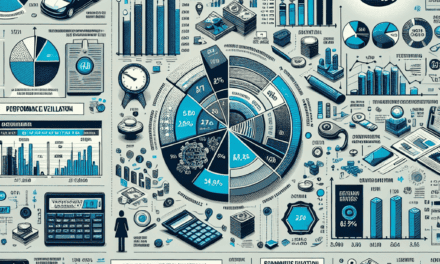“Markets Waver: Fed Caution Meets Retail Resilience”
Introduction
Markets experienced a downturn following recent remarks from the Federal Reserve and the release of robust retail sales data. Investors are closely monitoring the Fed’s comments, which suggest a potential continuation of tight monetary policy to combat inflation. This has sparked concerns about the impact on economic growth and corporate earnings. Meanwhile, stronger-than-expected retail sales figures indicate resilient consumer spending, adding complexity to the economic outlook. The combination of these factors has led to increased volatility in financial markets, as participants reassess their strategies in light of evolving economic conditions.
Impact Of Fed Remarks On Market Volatility
The recent decline in financial markets can be attributed to a confluence of factors, primarily the Federal Reserve’s remarks and unexpectedly strong retail sales data. These elements have collectively contributed to heightened market volatility, leaving investors to navigate an increasingly uncertain economic landscape. The Federal Reserve, as the central bank of the United States, plays a pivotal role in shaping monetary policy, and its statements are closely scrutinized by market participants. In its latest communication, the Fed signaled a potential shift in its policy stance, hinting at the possibility of future interest rate hikes. This prospect has injected a degree of uncertainty into the markets, as investors grapple with the implications of tighter monetary policy on economic growth and corporate profitability.
The Fed’s remarks come at a time when inflationary pressures are mounting, driven by supply chain disruptions and rising commodity prices. As a result, the central bank faces the delicate task of balancing its dual mandate of promoting maximum employment and ensuring price stability. The prospect of higher interest rates, while aimed at curbing inflation, raises concerns about the potential dampening effect on economic activity. Consequently, investors are recalibrating their expectations, leading to increased market volatility as they reassess the risk-reward dynamics of their portfolios.
Compounding the impact of the Fed’s remarks is the release of robust retail sales data, which has further complicated the market outlook. The stronger-than-expected retail sales figures suggest that consumer spending remains resilient, providing a boost to economic growth. However, this resilience also reinforces the case for the Fed to adopt a more hawkish stance, as sustained consumer demand could exacerbate inflationary pressures. The interplay between robust retail sales and the Fed’s potential policy shift has created a complex environment for investors, who must weigh the positive implications of strong consumer spending against the risks associated with tighter monetary policy.
In this context, market participants are closely monitoring economic indicators and corporate earnings reports for further clues about the trajectory of the economy. The heightened sensitivity to data releases underscores the fragile nature of investor sentiment, as any deviation from expectations can trigger significant market movements. Moreover, the global economic backdrop adds another layer of complexity, with geopolitical tensions and divergent monetary policies across major economies contributing to the overall uncertainty.
As investors navigate this challenging environment, diversification and risk management have become increasingly important. The need to balance potential returns with the preservation of capital has led to a more cautious approach, with many market participants seeking refuge in defensive sectors and assets. Additionally, the role of central bank communication in shaping market expectations cannot be overstated, as clear and consistent messaging is crucial in maintaining investor confidence.
In conclusion, the recent decline in markets underscores the intricate relationship between Federal Reserve policy, economic data, and market dynamics. The Fed’s remarks and robust retail sales data have collectively heightened market volatility, as investors grapple with the implications of potential interest rate hikes and their impact on economic growth. As the economic landscape continues to evolve, market participants must remain vigilant, adapting their strategies to navigate the complexities of an ever-changing environment. The interplay of these factors will likely continue to influence market behavior in the coming months, as investors seek to strike a balance between opportunity and risk in an uncertain world.
Retail Sales Data: A Double-Edged Sword For Investors
The recent downturn in financial markets has been significantly influenced by a confluence of factors, most notably the Federal Reserve’s remarks and the release of robust retail sales data. Investors, who are perpetually on the lookout for indicators that could signal shifts in economic policy or market trends, have found themselves in a precarious position. The retail sales data, while ostensibly a positive indicator of consumer confidence and economic health, has paradoxically contributed to market volatility, illustrating the complex interplay between economic indicators and investor sentiment.
To begin with, the retail sales data, which exceeded expectations, initially appeared to be a boon for the economy. Strong retail sales suggest that consumers are spending more, which typically signals a healthy economy. This uptick in consumer spending can lead to increased business revenues, potentially boosting corporate profits and, by extension, stock prices. However, this seemingly positive news has a darker side for investors, as it also raises concerns about inflationary pressures. When consumer demand is robust, it can lead to higher prices, prompting the Federal Reserve to consider tightening monetary policy to keep inflation in check.
In this context, the Federal Reserve’s recent remarks have added another layer of complexity. The Fed has indicated that it remains vigilant about inflation and is prepared to adjust interest rates accordingly. Such statements, while intended to reassure the public of the Fed’s commitment to maintaining economic stability, have instead heightened investor anxiety. The prospect of rising interest rates is often met with trepidation in the markets, as higher rates can increase borrowing costs for businesses and consumers alike, potentially slowing economic growth.
Moreover, the anticipation of tighter monetary policy can lead to a reevaluation of asset valuations. Investors may begin to question whether current stock prices accurately reflect the potential for future earnings growth in a higher interest rate environment. This reassessment can lead to sell-offs, as market participants seek to mitigate risk by reallocating their portfolios. Consequently, the combination of strong retail sales data and the Fed’s hawkish tone has created a double-edged sword for investors, who must now navigate the delicate balance between optimism about economic growth and caution regarding inflation and interest rates.
Furthermore, the global economic landscape adds another dimension to this intricate scenario. As central banks around the world grapple with similar challenges, the interconnectedness of global markets means that shifts in U.S. monetary policy can have far-reaching implications. Investors must consider not only domestic factors but also how international developments might influence market dynamics. This global perspective is crucial, as it underscores the complexity of making investment decisions in an increasingly interconnected world.
In conclusion, the recent market decline, spurred by the interplay between robust retail sales data and the Federal Reserve’s remarks, highlights the multifaceted nature of economic indicators and their impact on investor behavior. While strong consumer spending is generally a positive sign for the economy, it also raises concerns about inflation and potential interest rate hikes. As investors navigate this challenging environment, they must remain vigilant and adaptable, considering both domestic and global factors that could influence market trends. The current situation serves as a reminder of the delicate balance that exists between economic growth and stability, and the critical role that central banks play in maintaining this equilibrium.
Analyzing The Fed’s Influence On Stock Market Trends
The recent downturn in the stock markets has been attributed to a confluence of factors, primarily the Federal Reserve’s remarks and unexpectedly strong retail sales data. Investors are keenly aware of the Federal Reserve’s significant influence on market trends, as its monetary policy decisions can either buoy or dampen investor sentiment. In this context, the Fed’s recent comments have sparked concerns about the future trajectory of interest rates, leading to a decline in stock prices.
To understand the market’s reaction, it is essential to consider the Federal Reserve’s dual mandate of promoting maximum employment and maintaining stable prices. In recent months, the Fed has been navigating the delicate balance between fostering economic growth and curbing inflationary pressures. The central bank’s remarks, which hinted at the possibility of further interest rate hikes, have been interpreted by investors as a signal that the Fed is prioritizing inflation control over economic expansion. This perception has led to increased volatility in the stock markets, as higher interest rates typically result in higher borrowing costs for businesses and consumers, potentially slowing down economic activity.
Moreover, the release of robust retail sales data has added another layer of complexity to the market dynamics. Retail sales, a key indicator of consumer spending, have shown unexpected strength, suggesting that the economy remains resilient despite the Fed’s tightening monetary policy. While this data is generally positive, it has paradoxically contributed to market declines. The strong retail sales figures have reinforced the Fed’s stance on the need for continued rate hikes, as sustained consumer spending could exacerbate inflationary pressures. Consequently, investors are grappling with the prospect of a more aggressive monetary policy, which could weigh on corporate profits and economic growth.
In addition to these factors, the global economic landscape also plays a crucial role in shaping market trends. Geopolitical tensions, supply chain disruptions, and fluctuating commodity prices have created an environment of uncertainty, further complicating the investment landscape. As a result, market participants are increasingly risk-averse, seeking safe-haven assets such as government bonds, which offer more stable returns in times of economic uncertainty. This shift in investor sentiment has contributed to the decline in stock prices, as funds are reallocated from equities to fixed-income securities.
Furthermore, the interplay between domestic and international markets cannot be overlooked. The interconnectedness of global financial systems means that developments in one region can have ripple effects across the world. For instance, central banks in other major economies are also grappling with similar challenges, as they strive to balance growth and inflation. Their policy decisions can influence capital flows and exchange rates, thereby impacting the performance of domestic markets.
In conclusion, the recent decline in stock markets can be attributed to a complex interplay of factors, with the Federal Reserve’s remarks and robust retail sales data at the forefront. As investors navigate this challenging environment, they must remain vigilant and adaptable, considering both domestic and global economic indicators. The Fed’s influence on market trends is undeniable, and its future policy decisions will continue to be closely scrutinized by market participants. Ultimately, the path forward will depend on how effectively the central bank can manage inflationary pressures while supporting economic growth, a task that requires careful consideration and strategic foresight.
Retail Sector Resilience Amid Economic Uncertainty

The recent downturn in financial markets has been largely attributed to remarks from the Federal Reserve, coupled with unexpectedly strong retail sales data. These developments have created a complex landscape for investors and policymakers alike, as they navigate the intricate balance between economic growth and inflationary pressures. The resilience of the retail sector, in particular, has emerged as a focal point in this broader economic narrative, offering insights into consumer behavior and the underlying strength of the economy.
In recent weeks, the Federal Reserve has signaled its commitment to maintaining a tight monetary policy in response to persistent inflationary concerns. This stance has been underscored by comments from key Fed officials, who have emphasized the need for vigilance in curbing inflation. Consequently, these remarks have sparked apprehension among investors, leading to a decline in stock markets as they anticipate potential interest rate hikes. The prospect of higher borrowing costs has, in turn, raised concerns about the impact on corporate profits and economic growth.
Amid this backdrop of uncertainty, the retail sector has demonstrated remarkable resilience. Recent data indicates that retail sales have exceeded expectations, suggesting that consumer spending remains robust despite the challenges posed by inflation and rising interest rates. This strength in retail sales can be attributed to several factors, including a tight labor market, which has bolstered household incomes, and a shift in consumer preferences towards goods and services that align with post-pandemic lifestyles.
Moreover, the adaptability of retailers in responding to changing consumer demands has played a crucial role in sustaining sales momentum. Many retailers have embraced digital transformation, enhancing their e-commerce platforms and leveraging data analytics to better understand and cater to consumer needs. This strategic pivot has enabled them to capture a larger share of the market, even as traditional brick-and-mortar sales face headwinds.
However, the resilience of the retail sector does not entirely mitigate the broader economic challenges. The interplay between strong retail sales and the Federal Reserve’s monetary policy presents a conundrum. On one hand, robust consumer spending is a positive indicator of economic vitality, suggesting that households are confident in their financial prospects. On the other hand, sustained high levels of spending could exacerbate inflationary pressures, prompting the Fed to adopt more aggressive measures to rein in inflation.
As the Federal Reserve weighs its options, the retail sector’s performance will likely remain a key barometer of economic health. Policymakers will need to carefully consider the implications of their decisions on consumer behavior and the broader economy. In this context, maintaining a delicate balance between fostering economic growth and controlling inflation will be paramount.
In conclusion, the recent decline in markets, driven by Fed remarks and strong retail sales data, underscores the complexity of the current economic environment. While the resilience of the retail sector offers a glimmer of hope, it also highlights the challenges that lie ahead. As investors and policymakers navigate this uncertain terrain, the ability to adapt and respond to evolving economic conditions will be crucial in shaping the future trajectory of the economy. The coming months will undoubtedly be pivotal in determining how these dynamics unfold, with the retail sector continuing to play a central role in this unfolding economic narrative.
Investor Reactions To Mixed Economic Signals
In recent weeks, financial markets have experienced notable fluctuations, driven by a confluence of factors that have left investors grappling with mixed economic signals. The Federal Reserve’s recent remarks, coupled with unexpectedly strong retail sales data, have contributed to a complex landscape that has prompted varied reactions from market participants. As investors attempt to navigate these turbulent waters, understanding the interplay between these elements is crucial.
The Federal Reserve’s comments have been a focal point for investors, as they provide insights into the central bank’s monetary policy trajectory. In its latest communication, the Fed signaled a cautious approach, emphasizing its commitment to data-driven decision-making. While the central bank refrained from making any immediate changes to interest rates, it underscored the importance of monitoring inflationary pressures and labor market conditions. This stance, while intended to reassure markets of the Fed’s vigilance, has also introduced a degree of uncertainty. Investors are now left to speculate on the timing and magnitude of potential future rate hikes, which has contributed to heightened market volatility.
Simultaneously, the release of robust retail sales data has added another layer of complexity to the economic narrative. The data revealed a stronger-than-expected increase in consumer spending, suggesting that the economy remains resilient despite ongoing challenges. This uptick in retail sales is indicative of consumer confidence and a willingness to spend, which are positive signs for economic growth. However, it also raises concerns about inflationary pressures, as increased demand can lead to higher prices. This duality has left investors in a quandary, as they weigh the benefits of economic strength against the risks of rising inflation.
The juxtaposition of the Fed’s cautious remarks and the strong retail sales figures has created a challenging environment for investors. On one hand, the Fed’s emphasis on data dependency suggests a measured approach to monetary policy, which could provide stability in the long term. On the other hand, the robust retail sales data points to an economy that may be overheating, potentially necessitating more aggressive intervention by the central bank. This dichotomy has led to divergent interpretations among market participants, with some viewing the data as a harbinger of inflationary pressures, while others see it as a testament to economic resilience.
In response to these mixed signals, financial markets have experienced declines, as investors reassess their positions and adjust their expectations. The uncertainty surrounding the Fed’s future actions, combined with concerns about inflation, has prompted a reevaluation of risk and return profiles. Consequently, equities have faced downward pressure, while bond yields have fluctuated as investors seek safe havens amid the uncertainty. This recalibration reflects the broader sentiment of caution that has permeated the markets, as participants strive to balance optimism about economic growth with apprehension about potential policy shifts.
In conclusion, the recent market declines underscore the complexity of the current economic landscape, shaped by the interplay of Federal Reserve communications and robust retail sales data. As investors grapple with these mixed signals, the path forward remains uncertain. The challenge lies in discerning the implications of these developments and positioning portfolios accordingly. Ultimately, the ability to navigate this environment will hinge on a nuanced understanding of the evolving economic dynamics and a keen awareness of the potential risks and opportunities that lie ahead.
The Role Of Consumer Spending In Market Dynamics
Consumer spending plays a pivotal role in shaping market dynamics, acting as a barometer for economic health and influencing investor sentiment. Recent developments have underscored this relationship, as markets experienced a decline following remarks from the Federal Reserve and the release of robust retail sales data. Understanding the interplay between consumer behavior and market trends is essential for comprehending the broader economic landscape.
To begin with, consumer spending accounts for a significant portion of economic activity, particularly in developed economies like the United States, where it constitutes approximately two-thirds of the Gross Domestic Product (GDP). This substantial contribution means that fluctuations in consumer spending can have profound implications for economic growth and stability. When consumers are confident and willing to spend, businesses experience increased revenues, which can lead to expansion and job creation. Conversely, when consumer spending wanes, businesses may face reduced profits, potentially leading to cutbacks and layoffs.
In recent weeks, the release of robust retail sales data has highlighted the resilience of consumer spending. Despite various economic challenges, including inflationary pressures and geopolitical uncertainties, consumers have continued to open their wallets, driving retail sales higher than anticipated. This unexpected strength in consumer spending has provided a boost to certain sectors, such as retail and manufacturing, which rely heavily on consumer demand.
However, this positive news has been tempered by remarks from the Federal Reserve, which have introduced a degree of uncertainty into the markets. The Fed’s comments suggested a potential tightening of monetary policy in response to persistent inflationary pressures. While the central bank’s primary goal is to maintain price stability, any indication of interest rate hikes can have a cooling effect on economic activity. Higher interest rates can lead to increased borrowing costs for consumers and businesses alike, potentially dampening spending and investment.
The juxtaposition of strong retail sales data and the Fed’s cautious stance has created a complex environment for investors. On one hand, the resilience of consumer spending suggests that the economy remains robust, providing a foundation for continued growth. On the other hand, the prospect of tighter monetary policy raises concerns about the sustainability of this growth, as higher interest rates could eventually curb consumer spending and slow economic momentum.
In navigating this landscape, investors must weigh the potential risks and rewards associated with consumer spending trends and monetary policy shifts. While robust retail sales data may signal a healthy economy, the specter of rising interest rates could alter the trajectory of market dynamics. As such, investors are closely monitoring both consumer behavior and central bank actions to gauge the future direction of the markets.
In conclusion, consumer spending is a critical driver of market dynamics, influencing economic growth and investor sentiment. The recent decline in markets, amid Fed remarks and strong retail sales data, underscores the intricate relationship between consumer behavior and monetary policy. As the economic landscape continues to evolve, understanding the role of consumer spending in shaping market trends will remain essential for investors and policymakers alike. By keeping a close eye on these developments, stakeholders can better navigate the complexities of the modern economy and make informed decisions that align with their objectives.
Strategies For Navigating Market Declines And Economic Indicators
In the ever-evolving landscape of financial markets, investors are constantly seeking strategies to navigate periods of decline, especially when influenced by significant economic indicators. Recent remarks from the Federal Reserve, coupled with robust retail sales data, have contributed to a downturn in the markets, prompting investors to reassess their strategies. Understanding the interplay between these factors and market behavior is crucial for making informed investment decisions.
The Federal Reserve’s comments often serve as a barometer for market sentiment, influencing investor expectations regarding interest rates and economic policy. When the Fed signals potential rate hikes or a tightening of monetary policy, markets can react negatively, as higher interest rates typically increase borrowing costs and can dampen economic growth. In the current scenario, the Fed’s remarks have suggested a more hawkish stance, leading to concerns about the future trajectory of interest rates. This has, in turn, contributed to a decline in market indices, as investors recalibrate their portfolios in anticipation of a less accommodative monetary environment.
Simultaneously, robust retail sales data has added another layer of complexity to the market dynamics. Strong retail sales figures often indicate a healthy consumer sector, which is a critical component of economic growth. However, in the context of potential interest rate hikes, robust consumer spending can be a double-edged sword. On one hand, it reflects consumer confidence and economic resilience; on the other hand, it may fuel inflationary pressures, prompting the Fed to act more aggressively in curbing inflation. This delicate balance between encouraging economic growth and managing inflation is a key consideration for investors as they navigate market declines.
In light of these developments, investors are exploring various strategies to mitigate risks and capitalize on potential opportunities. Diversification remains a fundamental approach, as spreading investments across different asset classes can help cushion the impact of market volatility. By including a mix of equities, bonds, and alternative investments, investors can reduce their exposure to any single market downturn. Additionally, focusing on quality stocks with strong fundamentals and resilient business models can provide a buffer against economic uncertainties.
Moreover, maintaining a long-term perspective is essential during periods of market decline. While short-term fluctuations can be unsettling, historical data suggests that markets tend to recover over time. Investors who remain committed to their long-term investment goals are often better positioned to weather temporary downturns. This approach requires discipline and patience, as well as a willingness to stay the course even when market conditions are challenging.
Furthermore, staying informed about economic indicators and central bank policies is crucial for making timely and informed investment decisions. By closely monitoring developments such as retail sales data and Fed announcements, investors can better anticipate market movements and adjust their strategies accordingly. Engaging with financial advisors and leveraging research tools can also provide valuable insights and guidance.
In conclusion, navigating market declines amid significant economic indicators requires a multifaceted approach that balances risk management with strategic opportunities. By diversifying portfolios, maintaining a long-term perspective, and staying informed about economic developments, investors can better position themselves to navigate the complexities of the financial markets. As the interplay between Fed remarks and retail sales data continues to unfold, adopting these strategies can help investors manage uncertainty and achieve their financial objectives.
Q&A
1. **What caused the market decline?**
The market decline was primarily caused by remarks from the Federal Reserve indicating potential future interest rate hikes.
2. **What did the Federal Reserve say?**
The Federal Reserve suggested that interest rates might need to remain higher for longer to combat inflation, which unsettled investors.
3. **How did the retail sales data impact the market?**
Robust retail sales data indicated strong consumer spending, which could contribute to inflationary pressures, reinforcing the Fed’s stance on interest rates.
4. **Which sectors were most affected by the market decline?**
Interest rate-sensitive sectors, such as technology and real estate, were most affected by the market decline.
5. **How did bond yields react to the Fed’s remarks?**
Bond yields rose in response to the Fed’s remarks, reflecting expectations of higher interest rates.
6. **What was the market’s overall reaction to the retail sales data?**
While strong retail sales data is typically positive, in this context, it heightened concerns about inflation and potential rate hikes, contributing to the market decline.
7. **What are investors concerned about following the Fed’s remarks?**
Investors are concerned about the potential for prolonged high interest rates, which could slow economic growth and impact corporate profits.
Conclusion
The recent decline in markets can be attributed to a combination of hawkish remarks from the Federal Reserve and unexpectedly strong retail sales data. The Fed’s comments have reinforced expectations of continued monetary tightening, which has heightened investor concerns about the potential impact on economic growth and corporate earnings. Meanwhile, robust retail sales figures suggest that consumer spending remains resilient, potentially giving the Fed more leeway to maintain its aggressive stance on interest rates. This dual dynamic has created uncertainty in the markets, as investors weigh the implications of persistent inflationary pressures against the backdrop of a still-strong consumer sector. As a result, market participants are likely to remain cautious, closely monitoring economic indicators and Fed communications for further guidance on the trajectory of monetary policy and its impact on financial markets.





